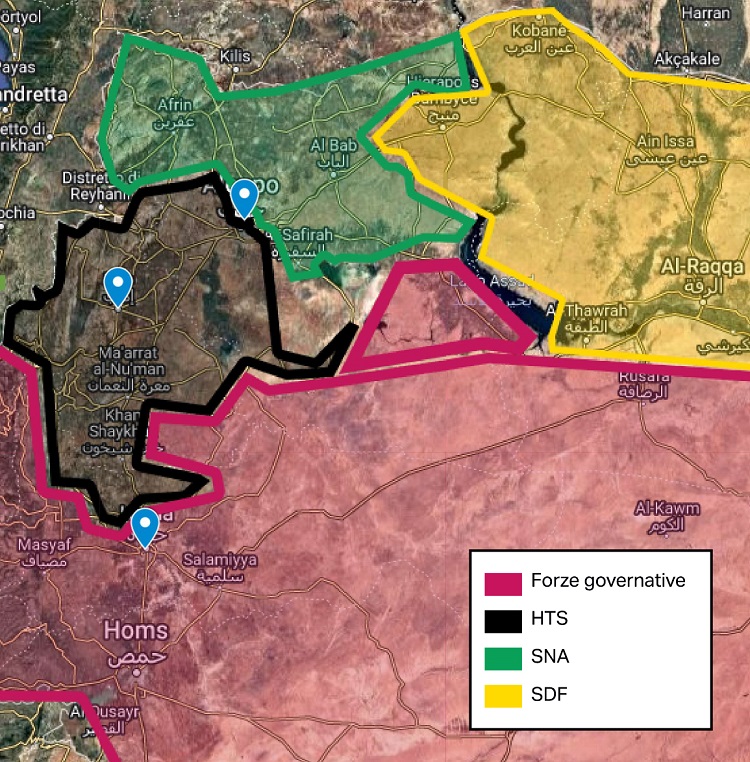
For years, Syria had not been in the mainstream news. The civil war had essentially been frozen and the regime had consolidated control over Damascus, the central part and the south, plus the coastal area and the main cities of the country, namely Homs, Aleppo, Hama.
However, the level of territorial control was much more solid in some areas, particularly on the coast, an area of traditional Alawite settlement, and in the capital, while in other areas it was more precarious. In the latter, such as Homs and Daraa, crystalization had been reached through reconciliation agreements with local insurgents, mediated by the Russians, while Aleppo had always been affected by the neighbouring rebel-controlled areas. And then, in recent years, Assad had regained a certain legitimacy, as Syria came back to the Arab League, several embassies reopened, and Emirati fund started flowing to the country. Beyond appearances, however, the Assad regime has continued to be structurally weak beacuse of a sectarian elite, a reduced base of support, and thus dependence on support from Moscow and Tehran.
Such a dependence includes arms supplies, air support, strategic and operational advising, and, above all, manpower, i.e., militias, starting with Hezbollah and including pro-Iranian Shiite militias from Afghanistan and Iraq. The Syrian Army remains weak, with a very limited recruitment pool - mainly relying on Alawite, Christian, and Druze minorities - and suffering many losses in a decade of civil war.
Against this background, two elements have convinced the rebels to act to change the status quo: the War in Ukraine, which has diverted Moscow's attention, and Israel's war against the so-called Axis of Resistance, which has reduced the rebels' level of force. The Israeli Air Force has repeatedly struck the Pasdaran and Hezbollah network in Syria in recent years/months, both in depth and in the border area with Lebanon.
The rebels' action was swift and carefully planned, and at one point seemed on the verge of causing the regime's collapse. The offensive was mainly conducted by HTS (Hay'at Tahrir al-Sham) - the front that groups together former al-Qaeda members, Al Nusra, and Salafist militias Ahrar al-Sham - which moved from the controlled areas in Idlib province and attacked Aleppo from the west, taking advantage of the substantial absence of defences by government forces (reasons for this absence include incompetence, corruption, and lack of funds, among others). In recent years, HTS has "moderated" its platform and thus obtained increasing support from Turkish security apparatuses: this was evident from their organization, uniform and equipment provisions, and operational methods.
HTS's action was the classic one conducted with heavily armed vehicles that "run" quickly in depth and are supported in their advance by rudimentary field rocket launchers (launchers mounted on vehicles and trucks) and the use of drones (both suicide FPV UAVs and ISR UAVs). A deadly combination that gives no reference points and has thrown the defenders and commands into disarray, with no time to "put together" a coherent reaction and defense line.
Aleppo was essentially taken without firing a shot, and HTS militias pushed eastward to take control of Aleppo airport (eastern outskirts of the city), after it was initially occupied by Kurdish SDF (Syrian Democratic Forces). The northern and eastern part, starting from the Tal Rifat area (to the north) and the Kuweires air base (to the east), was instead occupied by the SNA (Syrian National Army, the former Free Syrian Army, i.e., the Syrian Muslim Brotherhood, which enjoys Erdogan's official support), which moved from the controlled "cantons" of Al Bab and Afrin.
After some initial skirmishes, SNA militiamen also drove out the few SDF forces from the northern area of Aleppo (although some "pockets" seem to be resisting for now), whose pivot is represented by the YPG, the Syrian branch of the Kurdish military branch. The SDF forces have fallen back eastward to Manbij/Kobane, the area that effectively creates a discontinuity between the aforementioned Afrin/Al Bab canton and the other canton controlled by the SNA, namely Tell Abyad. In particular, SNA forces pushed from the Afrin area towards Tal Rifat, and from Al Bab southward taking control of the aforementioned Kuweires air base, then pushing further south to reach Lake Sabkhat al-Jabbul and the town of Al-Safirah (20 and 30 km southeast of Aleppo respectively). Therefore, the Kurds were forced to move eastward to avoid being "crushed" between HTS to the west and SNA to the north and east.
HTS militiamen, parallel to the advance on Aleppo, pushed from Idlib westward towards Saraqib, managing to cut the M5 highway connecting Aleppo with Damascus via Homs and Hama, and then began to advance along it southward, first reaching the important crossroads of Ma`arat al-Nu`man (about 70 km southwest of Aleppo) and then the village of Khan Shaykhun (about thirty kilometers north of Hama). In short, a debacle for the government forces with Commands that went into chaos and were unable to organize a coherent defense. A vacuum, lasting at least 3 days, during which a settling of scores also took place among the different factions in Damascus, probably over the possibility of opening to negotiations with to the rebels. But as we know, Assad is not keen to listening to that kind of talk and, in any case, Russia and Iran do not trust Erdogan. This notwithstanding, having overcome the initial crisis and avoided collapse, the government front began to reorganize somewhat.
HTS vanguards, which at one point had reached the outskirts of Hama, were pushed back and the Syrian Army recaptured a series of villages north of the city, while the Russian air task torce, based in Jableh/Latakia, began to hit rebel convoys, concentrations, and command centers hard (including in Idlib and Aleppo), and government forces also regrouped in the eastern part of Aleppo governorate.
Meanwhile, convoys of pro-Iranian Shiite militiamen began to flow in from neighboring Iraq. One of these seems to have been hit last night in the Mayadeen area by an US raid conducted with A-10s. A clear sign of Washington's intentions: to reduce Iranian (and Russian) influence in Syria, at least until Trump's arrival.
After years of frozen situation, therefore, a new phase of the long Syrian civil war opens, whose course could be influenced mainly by 4 unknowns:
1. The level of support from Moscow and Tehran for the government front.
2. The attitude of the SDF, traditionally ambivalent towards the regime.
3. Ankara's intentions, possibly beyond Aleppo and northern Syria.
4. The attitude of local factions in the "reconciled" areas of Homs and Daraa. The situation on the ground remains fluid and constantly changing, updates will follow.
The situation on the ground remains fluid and constantly changing, updates will follow.
Follow us on Telegram, Facebook and X.
(image: map of the area of operations by RID - Rivista Italiana Difesa; front lines are indicative. The icons on the map indicate, from north to south, Aleppo, Idlib and Hama).








.png)
